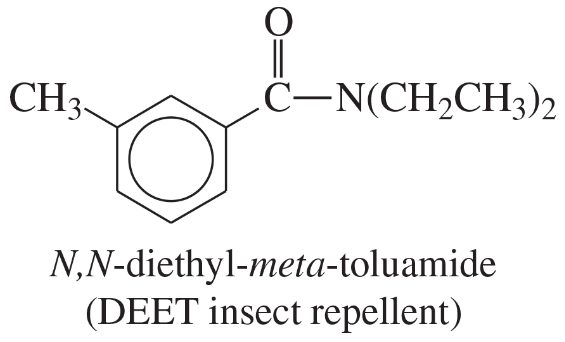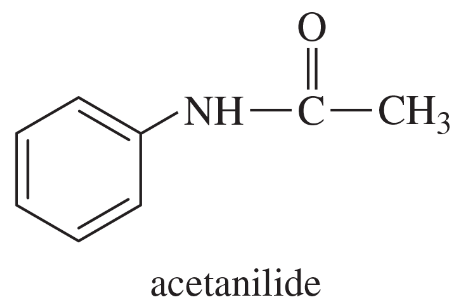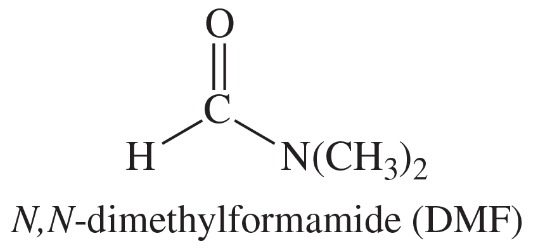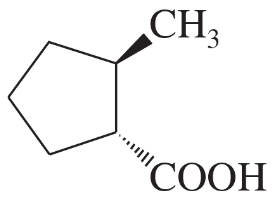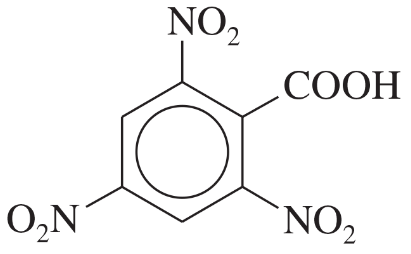 Back
BackProblem 12b
Propose a mechanism for the acid-catalyzed reaction of acetic acid with ethanol to give ethyl acetate.
Problem 12c
The Principle of Microscopic Reversibility states that a forward reaction and a reverse reaction taking place under the same conditions (as in an equilibrium) must follow the same reaction pathway in microscopic detail. The reverse of the Fischer esterification is the acid-catalyzed hydrolysis of an ester. Propose a mechanism for the acid-catalyzed hydrolysis of ethyl benzoate, PhCOOCH2CH3.
Problem 14
A carboxylic acid has two oxygen atoms, each with two nonbonding pairs of electrons.
(a) Draw the resonance forms of a carboxylic acid that is protonated on the hydroxy oxygen atom.
(b) Compare the resonance forms with those given previously for an acid protonated on the carbonyl oxygen atom.
(c) Explain why the carbonyl oxygen atom of a carboxylic acid is more basic than the hydroxy oxygen.
Problem 15a
Show how Fischer esterification might be used to form the following esters. In each case, suggest a method for driving the reaction to completion.
(a) methyl salicylate
Problem 15b
What monosaccharides are formed in a modified Kiliani–Fischer synthesis starting with each of the following monosaccharides?
b. L-threose
Problem 15c
Show how Fischer esterification might be used to form the following esters. In each case, suggest a method for driving the reaction to completion.
(c) ethyl phenylacetate
Problem 16a,b
The mechanism of the Fischer esterification was controversial until 1938, when Irving Roberts and Harold Urey of Columbia University used isotopic labeling to follow the alcohol oxygen atom through the reaction. A catalytic amount of sulfuric acid was added to a mixture of 1 mole of acetic acid and 1 mole of special methanol containing the heavy 18O isotope of oxygen. After a short period, the acid was neutralized to stop the reaction, and the components of the mixture were separated.
(a) Propose a mechanism for this reaction.
(b) Follow the labeled 18O atom through your mechanism, and show where it is found in the products.
Problem 17a
The given was missing some important resonance forms of the intermediates shown in brackets. Complete this mechanism by drawing all the resonance forms of these intermediates. Do your resonance forms help to explain why this reaction occurs under very mild conditions (water with a tiny trace of acid)?
Problem 17b
(b) Finish the solution for Solved Problem 20-1 by providing a mechanism for the acid-catalyzed hydrolysis of ethyl formate.
Problem 18a
Show how to synthesize the following compounds, using appropriate carboxylic acids and amines.
(a)
Problem 18b
Show how to synthesize the following compounds, using appropriate carboxylic acids and amines.
(b)
Problem 18c
Show how to synthesize the following compounds, using appropriate carboxylic acids and amines.
(c)
Problem 19
Show how you would synthesize the following compounds from the appropriate carboxylic acids or acid derivatives.
Problem 20a
Draw the following sugars using Haworth projections:
a. β-D-galactopyranose
Problem 20b
Draw the following sugars using Haworth projections:
b. α-D-tagatopyranose
Problem 21a1
Show how the following ketones might be synthesized from the indicated acids, using any necessary reagents.
(a) propiophenone from propionic acid (using alkylation of the acid)
Problem 21b
Show how the following ketones might be synthesized from the indicated acids, using any necessary reagents.
(b) methyl cyclohexyl ketone from cyclohexanecarboxylic acid
Problem 22
Propose a mechanism for the reaction of benzoic acid with oxalyl chloride. This mechanism begins like the thionyl chloride reaction, to give a reactive mixed anhydride. Nucleophilic acyl substitution by chloride ion gives a tetrahedral intermediate that eliminates a leaving group, which then fragments into carbon dioxide, carbon monoxide, and chloride ion.
Problem 23a
Propose mechanisms for the nucleophilic acyl substitutions to form ethyl benzoate as shown on the previous page.
Problem 23b
Propose mechanisms for the nucleophilic acyl substitutions to form N-methylacetamide as shown on the previous page.
Problem 24a
Show how you would use an acid chloride as an intermediate to synthesize.
(a) N-phenylbenzamide (PhCONHPh) from benzoic acid and aniline.
Problem 24b
Show how you would use an acid chloride as an intermediate to synthesize
(b) phenyl propionate (CH3CH2COOPh) from propionic acid and phenol.
Problem 25a,b
Give the IUPAC names of the following compounds.
(a) CH3CH2C≡CCOOH
(b) CH3CH(NH2)CH(OH)COOH
Problem 25c,d
Give the IUPAC names of the following compounds.
(c) (CH3)2C=CHCOOH
(d)
Problem 25e,f
Give the IUPAC names of the following compounds.
(e)
(f)
Problem 27f-i
Draw the structures of the following compounds.
(f) salicylic acid
(g) zinc undecanoate (athlete's-foot powder)
(h) sodium benzoate (a food preservative)
(i) sodium fluoroacetate (Compound 1080, a controversial coyote poison)
Problem 28
Show how you would use extractions with a separatory funnel to separate a mixture of the following compounds: benzoic acid, phenol, benzyl alcohol, aniline
Problem 29c,d
Arrange each group of compounds in order of increasing basicity.
c. sodium benzoate, sodium ethoxide, and sodium phenoxide
d. pyridine, sodium ethoxide, and sodium acetate
Problem 30a,b,c
Predict the products (if any) of the following acid–base reactions.
(a) acetic acid + ammonia
(b) phthalic acid + excess NaOH
(c) p-toluic acid + potassium trifluoroacetate
Problem 30d,e
Predict the products (if any) of the following acid–base reactions.
(d) α-bromopropionic acid + sodium propionate
(e) benzoic acid + sodium phenoxide





